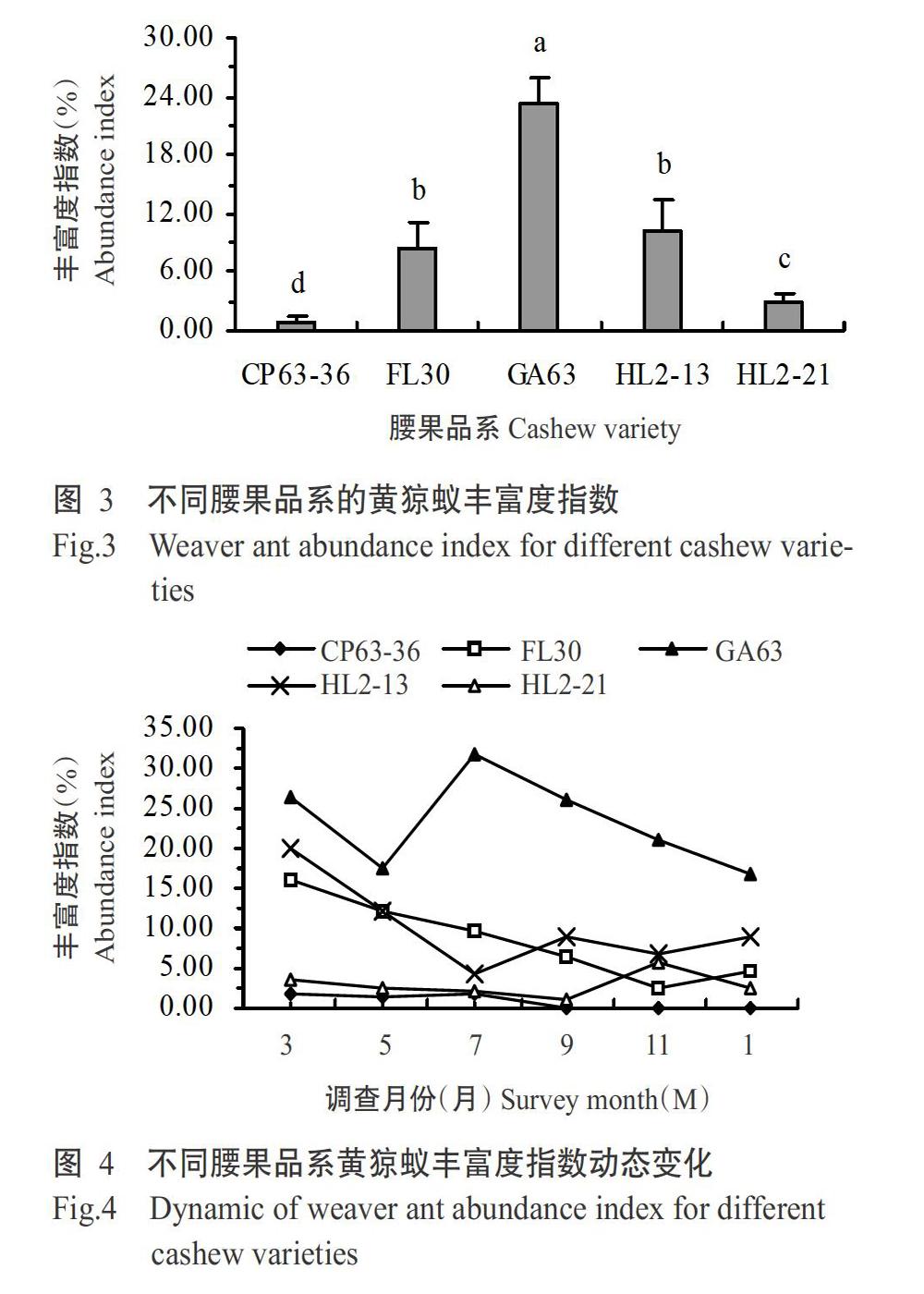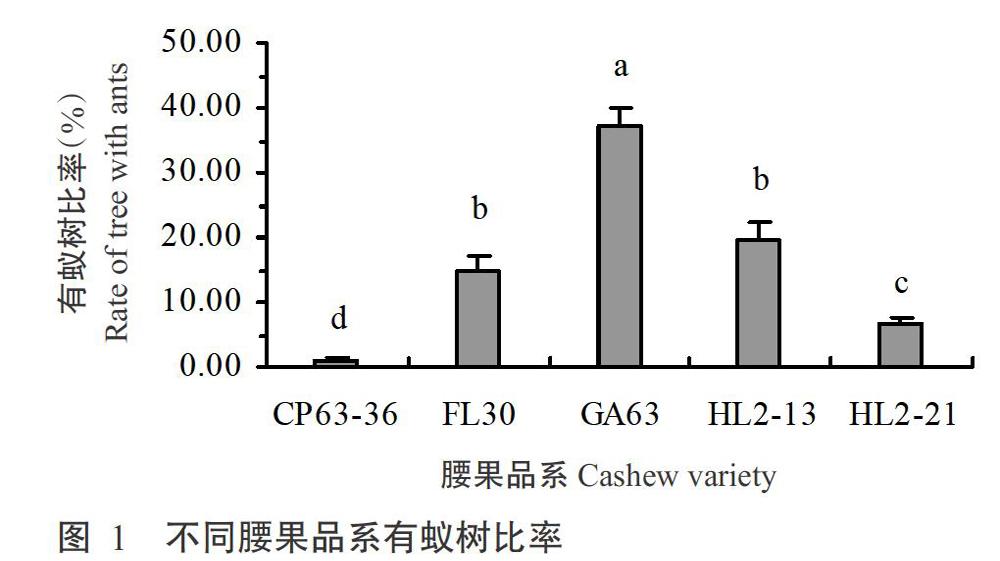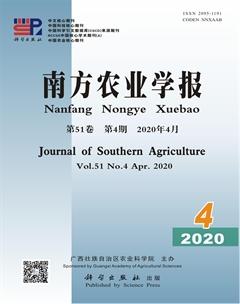黄猄蚁在不同腰果品系上的分布及动态研究
张中润 高燕 黄伟坚 黄海杰 肖丽燕



摘要:【目的】掌握黃猄蚁在不同腰果品系上的分布及动态特征,筛选出黄猄蚁丰富度较高的腰果品系,为壮大其种群数量开展腰果害虫生物防治提供参考依据。【方法】选取5个优良腰果品系(CP63-36、FL30、GA63、HL2-13和HL2-21),于2017年3月—2018年1月每隔2个月调查1次不同腰果品系植株上的黄猄蚁活动数量,计算有蚁树比率和丰富度指数并分析其动态。【结果】5个腰果品系均发现有黄猄蚁分布,但不同腰果品系的有蚁树比率和黄猄蚁丰富度指数均存在显著差异(P<0.05),其中GA63上的有蚁树比率和黄猄蚁丰富度指数均最大,分别为37.21%和23.29%,其次是HL2-13、FL30和HL2-21,CP63-36上的有蚁树比率和黄猄蚁丰富度指数最低,分别为1.14%和0.83%。不同腰果品系的有蚁树比率和黄猄蚁丰富度指数动态存在差异,其中GA63上的有蚁树比率和黄猄蚁丰富度指数在观察期内始终保持在高位,均在7月出现明显峰值,分别为48.84%和31.63%,最低值分别出现在5和1月,分别为27.91%和16.92%。【结论】腰果品系GA63上黄猄蚁的种群数量最大。枝繁叶茂的树体结构是有利于黄猄蚁分布的重要因素。
关键词: 黄猄蚁;腰果;有蚁树比率;丰富度指数
Abstract:【Objective】To clarify the distribution and dynamics of weaver ant(Oecophylla smaragdina Fabricius) on different cashew varieties, screen the cashew varieties with high weaver ant abundance and provide reference for increa-sing the population of weaver ant in biological control of cashew pests. 【Method】Five fine varieties(CP63-36, FL30, GA63, HL2-13 and HL2-21) were selected for this study, the number of weaver ant on cashew plants of different cashew varieties were observed from March, 2017 to January, 2018 through field survey at two months intervals, then calculated the rate of tree with ants and weaver ant abundance, and analyzed the dynamics. 【Result】The results showed that, the weaver ants were found in all five cashew varieties, but the differences in both trees with ants rate and abundance index among the five cashew varieties were significant(P<0.05). Cashew variety GA63 had the highest trees with ants rate(37.21%) and weaver ant abundance index(23.29%), followed by cashew varieties HL2-13,FL30 and HL2-21. CP63-36 had the lowest trees with ants rate(1.14%) and weaver ant abundance index(0.83%). The rate of tree with ants and wea-ver ant abundance index of different cashew varieties were different in dynamics, those of GA63 maintained at high level du-ring the observation period, and appeared obvious peaks in July, which were 48.84% and 31.63% respectively, and the lowest values occurred in May and January, which were 27.91% and 16.92%. 【Conclusion】The weaver ant population is the biggest on cashew variety GA63, luxuriant foliage may be an important factor for the distribution of weaver ant.
0 引言
【研究意义】黄猄蚁(Oecophylla smaragdina Fabricius)又名黄柑蚁、红树蚁,在我国热带、南亚热带地区均有分布(张祖兵等,2011)。黄猄蚁通过在多种热带亚热带经济树种上织叶结巢,可捕食或趋避多种害虫(Mele et al.,2010)。黄猄蚁在我国用于柑桔害虫防治,是世界上最早的害虫生物防治先例(陈守坚,1962)。黄猄蚁是海南省腰果种植区重要的生物防治因子,在昌江县、乐东县和东方市等腰果种植区均有丰富的黄猄蚁资源分布(张中润等,2009)。掌握黄猄蚁在不同腰果品系上的分布及动态特征,可为其创造良好的生存环境,壮大种群数量,充分发挥其在害虫生物防治中的作用。【前人研究进展】迄今为止,黄猄蚁已报道可用于防治柑橘(杨沛,2002)、芒果(Peng and Christian,2004,2005,2007)、椰子(Greenslade,1971)、可可(Stapley,1980)、油棕(Way and Khoo,1992)、桉树(Macfarlane et al.,1976)和红树林(Offenberg et al.,2004)等寄主植物上的害虫。黄猄蚁也可用于防治腰果害虫,Peng等(1995,1997,1999,2014)发现黄猄蚁对腰果害虫朋尼角盲蝽(Helopeltis pernicialis Stonedahl)、芒果重尾夜蛾[Penicillaria jocosatrix (Guenee)]、土黄缘蝽[Amblypelta lutescens(Distant)]、腰果卷叶螟(Anigraea ochrobasis Hampson)和红带蓟马[Selenothrips rubrocictus(Giard)]均有一定的控制效果,黄猄蚁数量较多的腰果树生产的腰果质量显著优于数量较少的腰果树。Mahapatro和Mathew(2016)也发现有黄猄蚁蚁巢的腰果植株受角盲蝽(Helopeltis spp.)的危害显著降低,并建议对有黄猄蚁定殖的腰果植株不要喷药防治病虫害,以免伤害黄猄蚁,降低其对腰果害虫的防控作用。在非洲,与黄猄蚁同属异种的长结织叶蚁也被证实对多种刺吸性腰果害虫如椰缘蝽(Pseudotheraptus wayi Brown)和角盲蝽有良好的控制作用,其对腰果害虫的防治效果与化学药剂相似(Dwomoh et al.,2009;Olotu et al.,2012;Abdulla et al.,2017)。除了较好的防控害虫效果外,黄猄蚁在腰果园中的种群数量也极为丰富(张中润等,2009),特别是在老腰果园中黄猄蚁经常是蚂蚁中的优势种群(Vanitha et al.,2017),说明腰果园的生态环境十分适合黄猄蚁的发展定殖。黄猄蚁在腰果园中还扮演传粉昆虫的角色(Vanitha and Raviprasad,2019),有利于提高腰果产量。同时,腰果特殊的生产模式也有利于应用黄猄蚁进行害虫防控,腰果可等待果实成熟后落到地上再收集,从而减少果农受黄猄蚁叮咬的烦恼。【本研究切入点】在前人的研究中,发现枝叶较密的寄主植物上黄猄蚁蚁巢较多(杨沛,2002),但未见对同一寄主植物不同品种黄猄蚁分布差异的研究。在腰果园中,不同的腰果品系由于其形态特征、生理特征及营养物质资源不同,提供给黄猄蚁的栖息环境也不同,可能会导致黄猄蚁在不同腰果品系上的分布选择存在差异。【拟解决的关键问题】选取5个优良腰果品系,研究不同腰果品系的有蚁树比率和黄猄蚁丰富度指数,分析黄猄蚁在不同腰果品系上的动态特征及影响其分布的因素,以期筛选出黄猄蚁丰富度较高的腰果品系,为壮大其种群数量开展腰果害虫生物防治提供参考依据。
1 材料與方法
1. 1 试验地概况
试验果园位于海南省乐东县利国镇海南省腰果研究中心(东经108°52′,北纬18°31′),燥红土,面积2.0 ha。当地年平均气温25.0~26.0 ℃,最冷月(1月)月平均气温20.0~22.0 ℃,年降水量1000~1300 mm,年蒸发量1800~2300 mm,年平均风速3.9 m/s,是海南省最适宜种植腰果的地区之一(江式邦和邓德生,1981)。供试腰果树为1989年定植的嫁接苗,株行距6.0 m×6.0 m。全园的田间管理措施一致,不施用任何农药。
1. 2 试验材料
参试的5个腰果品系为CP63-36、FL30、GA63、HL2-13和HL2-21,由于试验观察过程中一些腰果植株被强降雨和台风破坏,腰果品系GA63的调查样本数在不同调查时间有变动。5个腰果品系的植株特性(江式邦和邓穗生,1993;黄伟坚等,2007)和调查数量见表1。
1. 3 有蚁腰果植株及黄猄蚁分布指数调查
2017年3月—2018年1月,每次调查时间为当月中下旬,每隔2个月调查1次。每株腰果树调查是否有黄猄蚁活动,记录不同腰果品系的有蚁树数量及调查树总数,计算有蚁树比率。发现有黄猄蚁的腰果植株则调查主干及主枝上的黄猄蚁活动数量,按黄猄蚁数量n=0,0
有蚁树比率(%)=有蚁树总数/调查腰果树总数×100
丰富度指数(%)=[Σ(各级有蚁植株数×各级级别)]/(调查植株总数×最高级 别)×100
1. 4 统计分析
试验数据采用Excel 2016进行计算,运用SPSS 21.0进行单因素方差分析(One-way ANOVA),百分数值均经反正弦变换后进行方差分析,采用LSD法进行多重比较。
2 结果与分析
2. 1 不同腰果品系有蚁树比率调查结果
不同腰果品系有蚁树比率见图1。5种不同腰果品系的有蚁树比率从高到低依次为GA63>HL2-13>FL30>HL2-21>CP63-36,不同腰果品系有蚁树比率差异显著(F=45.122,P<0.05)。其中,品系GA63上有黄猄蚁活动的植株比率最高,其有蚁树比率为37.21%,显著高于其他腰果品系(P<0.05,下同);品系HL2-13和FL30的有蚁树比率相近,分别为19.44%和14.67%,两者间无显著差异(P>0.05,下同),但均显著高于品系HL2-21和CP63-36;品系CP63-36的有蚁树比率最低,仅为1.14%。
2. 2 不同腰果品系有蚁树比率动态变化
不同腰果品系有蚁树比率动态见图2。品系GA63的有蚁树比率在观察期内始终保持较高水平,在7月出现一个明显峰值(48.84%),最低值为27.91%(5月),其余月份保持在35.00%左右;品系HL2-13的有蚁树比率在观察期内整体上呈下降趋势,最高值为33.33%(3月),最低值为11.11%(9月);品系FL30的有蚁树比率在观察期内整体上也呈下降趋势,有蚁树比率最高值为24.00%(3月),最低值为0.08%(11和1月);品系HL2-21的有蚁树比率在观察期内均保持较低水平,除11月(11.76%)外其余月份的有蚁树比率均在10.00%以下,有蚁树比率整体动态相对平稳;品系CP63-36的有蚁树比率在3、5和7月均保持极低水平,比率均为2.27%,且在9、11月和翌年1月未观察到有黄猄蚁活动。
2. 3 不同腰果品系黄猄蚁丰富度指数调查结果
不同腰果品系的黄猄蚁丰富度指数见图3。5种不同腰果品系的黄猄蚁丰富度指数排序与有蚁树比率相似,从高到低依次为GA63>HL2-13>FL30>HL2-21>CP63-36,不同腰果品系黄猄蚁丰富度指数差异显著(F=29.384,P<0.05)。其中,品系GA63的黄猄蚁丰富度指数最大,为23.29%,显著高于其他4个腰果品系;品系HL2-13的丰富度指数(10.19%)与品系FL30的丰富度指数(8.53%)差异不显著,但均显著高于品系HL2-21和CP63-36;品系HL2-21的黄猄蚁丰富度指数为2.53%,显著低于腰果品系GA63、HL2-13和FL30,但显著高于品系CP63-36;品系CP63-36的黄猄蚁丰富度指数最低,仅为0.83%。
2. 4 不同腰果品系黄猄蚁丰富度指数动态变化
不同腰果品系黄猄蚁丰富度指数动态变化见图4。 品系GA63的黄猄蚁丰富度指数在7月出现明显峰值,为31.63%,最低值出现在1月(16.92%),其丰富度指数在观察期内始终保持高位;品系HL2-13的黄猄蚁丰富度指数最高值为20.0%(3月),最低值为4.44%(7月),其丰富度指数在观察期内相对较高,整体指数呈下降趋势;品系FL30的黄猄蚁丰富度指数最高值为16.00%(3月),最低值为2.40%(11月),其丰富度指数在观察期内几乎呈直线下降趋势;品系HL2-21的黄猄蚁丰富度指数最高值为5.56%(11月),最低值为1.11%(9月),其丰富度指数在观察期内相对较低,整体指数呈轻微上升趋势;品系CP63-36的黄猄蚁丰富度指数在3、5和7月均低于2.00%,且在9、11月和翌年1月未见有黄猄蚁活动。
3 讨论
本研究发现5个优良腰果品系均有黄猄蚁分布,但在相同环境条件下,不同腰果品系的黄猄蚁丰富度指数存在显著差异。黄猄蚁最喜在腰果品系GA63上活动、定居和繁殖,其黄猄蚁丰富度指数显著高于其他腰果品系,其次为腰果品系HL2-13、FL30和HL2-21,黄猄蚁在腰果品系CP63-36上的分布非常少。
在相同环境条件下,黄猄蚁在不同腰果品系上的分布差异可能受以下4个因素影响:一是供试腰果品系枝叶繁茂,可为黄猄蚁及其蚁巢提供很好的保护,降低暴风雨的直接冲击和破坏;二是腰果品系的嫩叶、花及发育中的果梨和坚果可分泌更多蜜汁,为黄猄蚁提供丰富的营养物质;三是腰果品系的嫩梢、花和果实等可吸引更多可被黄猄蚁捕食的昆虫前来为害,从而为黄猄蚁提供丰富的食物来源;四是供试腰果品系可吸引更多与黄猄蚁有共生关系的昆虫如粉蚧、蚜虫或介壳虫前来为害,而这些昆虫可分泌蜜露为黄猄蚁提供营养物质(Way,1963),从而吸引黄猄蚁在该腰果品系上定居和繁殖。
作为优良高产腰果品系,GA63、HL2-13和FL30均生长旺盛,枝叶与其他腰果品系相比较繁茂(江式邦和邓穗生,1993;黄伟坚等,2007),均可为黄猄蚁提供较好的定殖环境;同时,这3种腰果品系上存在一定数量且可被黄猄蚁捕食的害虫,田间观察发现腰果品系上与黄猄蚁有共生关系的昆虫数量也较多,可能是导致黄猄蚁在这些腰果品系上分布相对较多的原因之一。品系HL2-21为抗风型腰果品系,生长缓慢,植株较矮小(江式邦和邓穗生,1993),且对多种腰果害虫表现很高的抗性,缺少黄猄蚁可捕食的害虫(张中润等,2008,2010,2011),同时,该品系上与黄猄蚁有共生关系的昆虫危害也很少,因此黄猄蚁在该品系上的丰富度指数相对较低。CP63-36也是优良高产腰果品系,其枝叶也较繁茂,但该品系对多种腰果害虫较敏感,在自然条件下受茶角盲蝽、腰果细蛾和脊胸天牛等害虫的危害较严重(张中润等,2008,2010,2011),在一定程度上破坏其树体枝叶结构,从而影响了黄猄蚁选择这些腰果品系作为栖息地,导致黄猄蚁分布指数相对较低。
在以后的研究中,有必要进一步研究不同腰果品系的形态特性、生理特性、害虫种群密度、共生昆虫及气候因素等对黄猄蚁活动、定居和繁殖的影响,从而为应用黄猄蚁开展害虫生物防治打下基础。
4 结论
腰果品系GA63上黄猄蚁的种群数量最大。枝繁叶茂的树体结构是有利于黄猄蚁分布的重要因素。
参考文献:
陈守坚. 1962. 世界上最古老的生物防治——黄柑蚁Oecophylla smaragdina Fabr.在柑桔园中的放饲及其利用价值[J]. 昆虫学报,11(4): 401-408. [Chen S J. 1962. The most ancient biological control in the world—On the rai-sing of Oecophylla smaragdina(Fabricius) in citrus garden and its utilization value[J]. Acta Entomolgica Sinica,11(4): 401-408.]
黄伟坚,梅新,梁李宏,张中润. 2007. 5个腰果高产无性系农艺经济性状比较[J]. 热带农业科学,27(4): 18-20. [Huang W J,Mei X,Liang L H,Zhang Z R. 2007. Comparison of agronomic and economic characteristics of five cashew clones[J]. Chinese Journal of Tropical Agriculture,27(4): 18-20.]
江式邦,邓德生. 1981. 海南岛腰果生产潜力及区划意见[J]. 热带农业科学,(5): 96-103. [Jiang S B,Deng D S. 1981. Cashew production potential and its regionalization suggestions in Hainan[J]. Chinese Journal of Tropical Agriculture,(5): 96-103.]
江式邦,邓穗生. 1993. 海南腰果新种质研究[J]. 热带作物研究,(1): 34-37. [Jiang S B,Deng S S. 1993. Research on cashew new germplasms in Hainan[J]. Tropical Crop Research,(1): 34-37.]
杨沛. 2002. 黄猄蚁史料及其用于柑桔害虫防治的研究[J]. 中国生物防治,18(1): 28-32. [Yang P. 2002. Historical perspective of the red tree ant,Oecophylla smaragdina and its utilization against citrus insect pests[J]. Chinese Journal of Biological Control,18(1): 28-32.]
张中润,梁李宏,黄伟坚,王金辉,黄海杰. 2008. 5個不同腰果品系对腰果细蛾抗虫性研究[J]. 植物保护,34(5): 113-115. [Zhang Z R,Liang L H,Huang W J,Wang J H,Huang H J. 2008. Evaluation of the resistance of five cashew germplasms to the cashew miner[J]. Plant Protection,34(5): 113-115.]
张中润,梁李宏,黄伟坚,王金辉,黄海杰. 2009. 海南腰果种植区黄猄蚁资源调查[J]. 环境昆虫学报,31(1): 68-72. [Zhang Z R,Liang L H,Huang W J,Wang J H,Huang H J. 2009. Investigation of occurrence of weaver ant Oecophylla smaragdina in cashew plantations of Hainan Province[J]. Journal of Environmental Entomology,31(1): 68-72.]
張中润,梁李宏,黄伟坚,王金辉,黄海杰. 2010. 5个不同腰果品系对茶角盲蝽的抗虫性[J]. 热带作物学报,31(1): 122-125. [Zhang Z R,Liang L H,Huang W J,Wang J H,Huang H J. 2010. Evaluation of the resistance of five cashew clones to tea mosquito bug(Helopeltis theivora Waterhouse)[J]. Chinese Journal of Tropical Crops,31(1): 122-125.]
张中润,梁李宏,黄伟坚,王金辉,黄海杰. 2011. 5个不同腰果品系对脊胸天牛的抗虫性[J]. 植物保护,37(4): 82-86. [Zhang Z R,Liang L H,Huang W J,Wang J H,Huang H J. 2011. Evaluation of the resistance of five cashew clones to the cashew long-horned beetle[J]. Plant Protection,37(4): 82-86.]
张祖兵,段波,周明,李国华. 2011. 西双版纳橡胶盔蚧与蚂蚁的相互关系[J]. 生态学杂志,30(12): 2863-2867. [Zhang Z B,Duan B,Zhou M,Li G H. 2011. Interactions between nigra scale Parasaissetia nigra and ant in Xi-shuangbanna of Yunnan Province,Southwest China[J]. Chinese Journal of Ecology,30(12): 2863-2867.]
Abdulla N R,Rwegasira G M,Jensen K M V,Mwatawala M W,Offenberg J. 2017. Potential of Oecophylla longinoda Latreille (Hymenoptera: Formicidae) in managing major insect pests in organic cashew production systems[J]. Organic Agriculture,7(2): 95-104.
Dwomoh E A,Afun J V K,Ackonor J B,Agene V N. 2009. Investigations on Oecophylla longinoda(Latreille)(Hymenoptera: Formicidae) as a biocontrol agent in the protection of cashew plantations[J]. Pest Management Scien-ce,65(1): 41-46.
Greenslade P J M. 1971. Interspecific competition and frequency changes among ants in Solomon islands coconut plantations[J]. Journal of Applied Ecology,8(2): 323-352.
Macfarlane R,Jackson G V H,Marten K D. 1976. Die-back of eucalyptus in the Solomon islands[J]. Commonwealth Forestry Review,55(2): 133-139.
Mahapatro G K,Mathew J. 2016. Role of red-ant,Oecophylla smaragdina Fabricius(Formicidae: Hymenoptera) in ma-naging tea mosquito bug,Helopeltis species(Miridae: Hemiptera) in cashew[J]. Proceedings of the National Academy of Sciences,India Section B: Biological Scienc-es,86(2): 497-504.
Mele P V. 2010. A historical review of research on the weaver ant Oecophylla in biological control[J]. Agricultural and Forest Entomology,10(1): 13-22.
Offenberg J,Havanon S,Aksornkoae S,Maclntosh D J,Nielsen M G. 2004. Observations on the ecology of weaver ants(Oecophylla smaragdina Fabricius) in a thai mangrove ecosystem and their fffect on herbivory of Rhizophora mucronata Lam.[J]. Biotropica,36(3): 344-351.
Olotu M I,du Plessis H,Seguni Z S,Maniania N K. 2012. Efficacy of the African weaver ant Oecophylla longinoda (Hymenoptera: Formicidae) in the control of Helopeltis spp.(Hemiptera:Miridae) and Pseudotheraptus wayi (Hemiptera: Coreidae) in cashew crop in Tanzania[J]. Pest Management Science,69(8): 911-918.
Peng R K,Christian K. 2004. The weaver ant,Oecophylla smaragdina(Hymenoptera: Formicidae),an effective biological control agent of the red-banded thrips,Selenothrips rubrocinctus(Thysanoptera: Thripidae) in mango crops in the Northern Territory of Australia[J]. International Journal of Pest Management,50(2): 107-114.
Peng R K,Christian K. 2005. The control efficacy of the weaver ant,Oecophylla smaragdina (Hymenoptera: Formicidae),on the mango leafhopper,Idioscopus nitidulus (Hemiptera:Cicadellidae) in mango orchards in the Nor-thern Territory[J]. International Journal of Pest Management,51(4): 297-304.
Peng R K,Christian K. 2007. The effect of weaver ant,Oecophylla smaragdina(Hymenoptera:Formicidae),on the mango seed weevil,Sternochetus mangiferae(Coleoptera: Curculionidae),in mango orchards in the Northern Territory of Australia[J]. International Journal of Pest Mana-gement,53(1): 15-24.
Peng R K,Christian K,Gibb K. 1995. The effect of the green ant,Oecophylla smaragdina(Hymenoptera: Formicidae),on insect pests of cashew trees in Australia[J]. Bulletin of Entomological Research,85: 279-284.
Peng R K,Christian K,Gibb K. 1997. Control threshold ana-lysis for the tea mosquito bug,Helopeltis perniclalis(Hete-roptera:Miridae) and preliminary results concerning the efficiency of control by the green ant,Oecophylla smaragdina(Hymenoptera: Formicidae) in northern Australia[J]. International Journal of Pest Management,43(3): 233-237.
Peng R K,Christian K,Gibb K. 1999. The effect of colony isolation of the predacious ant,Oecophylla smaragdina (F.)(Hymenoptera: Formicidae),on protection of cashew plantations from insect pests[J]. International Journal of Pest Management,45(3): 189-194.
Peng R K,Christian K,Gibb K. 2014. Ecology of the fruit spotting bug,Amblypelta lutescens lutescens Distant(Hemiptera: Coreidae) in cashew plantations,with particular reference to the potential for its biological control[J]. Australian Journal of Entomology,44(1): 45-51.
Stapley J H. 1980. Using the predatory ant,Oecophylla smaragdina,to control insect pests of coconuts and cocoa[J]. Information Circular South Pacific Commission,85:5.
Vanitha K,Bhat P S,Raviprasad T N,Srikumar K K. 2017. Species composition of ants in cashew plantations and their interrelationships with cashew[J]. Proceedings of the National Academy of Sciences,India Section B: Biological Sciences,87(2): 399-409.
Vanitha K,Raviprasad T N. 2019. Diversity,species richness and foraging behaviour of pollinators in cashew[J]. Agricultural Research,8(2): 197-206.
Way M J,Khoo K C. 1992. Role of ants in pest management[J]. Annual Review of Entomology,37(1): 479-503.
Way M J. 1963. Mutualism between ants and honeydew-producing Homoptera[J]. Annual Review of Entomology,8(1): 307-344.
(責任编辑 麻小燕)

